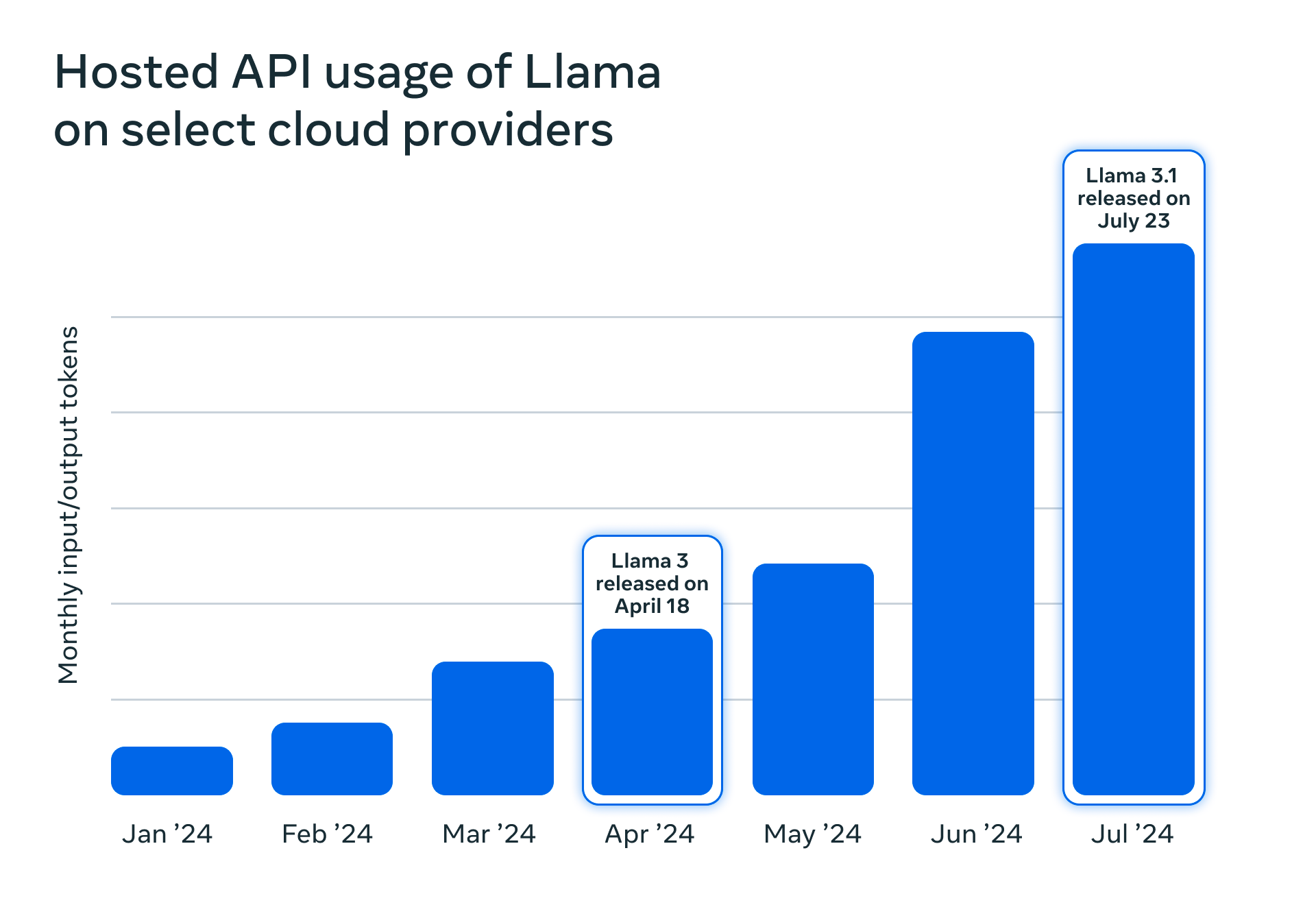Meta’s Llama AI Experiences Remarkable 10x Surge in Open Source Downloads 🚀
Open-source AI is steadily gaining ground against traditional closed-source models, and recent data from Meta demonstrates this shift dramatically. The company shared a mid-year update indicating that the downloads of its Llama family of models have skyrocketed, particularly following the launch of the powerful Llama 3.1 model last month.
Meta’s Significant Growth in Model Downloads
According to Meta, downloads for the Llama models are approaching an impressive 350 million on Hugging Face, representing a staggering tenfold growth from the previous year. This growth reflects not only an increase in downloads but a substantial rise in adoption among major enterprises like Zoom, Spotify, Infosys, AT&T, and Goldman Sachs. These companies are utilizing Llama models for a variety of both internal and external applications.
Meta’s Llama has emerged as a leading platform in the AI space. An increasing number of organizations, ranging from startups to large corporations, and even government bodies, are utilizing it to develop innovative products and services.
Researchers and engineers are actively enhancing Llama, fostering further advancements in the field.
Open Source AI Gaining Momentum
This update highlights a crucial point: open-source AI, which began its journey slowly, is now not only matching but also excelling in performance when compared to closed-source alternatives. The enterprise-level traction of these models is fueling real-world applications and challenging the dominance of giants like OpenAI, which has faced criticism for failing to deliver groundbreaking AI products beyond mere announcements.
Meta’s Strategic Open-Source Approach
Despite OpenAI’s initial advantage in the generative AI sector, Meta responded swiftly with its Llama model, launching just three months after the model behind ChatGPT. However, unlike its competitors, Meta adopted an open-source strategy, ensuring that its ecosystem—including Llama 2, Llama 3, and the latest Llama 3.1—remains accessible via Hugging Face and various cloud partners.
Meta stated, “By making our Llama models openly available, we have fostered a vibrant and diverse AI ecosystem, enabling developers to explore greater choices and capacities than ever before. The wave of innovation is broad and swift, with startups exploring new frontiers and enterprises of all sizes utilizing Llama models.”
Emerging Competitors: Mistral’s Approach
French startup Mistral has also embraced a similar strategy for many of its models, thus providing developers with several robust open-source models to build upon. Some of these open models are achieving parity or even surpassing their closed-source counterparts in specific metrics, exemplified by projects such as:
- FinGPT
- BioBert
- Defog SQLCoder
- Phind
Surge in Downloads Reflects Growing Interest
Meta’s open-source strategy began to show significant results following the launch of Llama 2 last July. Since that release, downloads for the company’s models have soared more than tenfold on Hugging Face, nearing 350 million. The previous month alone saw over 20 million downloads on the platform, indicating continued growth driven by the recent launch of Llama 3.1, which boasts 405 billion parameters.
“We are witnessing an increasing preference for Llama within the developer community, supported by strong indicators of ongoing growth. According to a survey conducted by Artificial Analysis, an independent AI benchmarking site, Llama ranked as the second most considered model and is recognized as the industry leader in open source,” the company elaborated.
Notable Enterprises Embracing Llama Models
Numerous enterprises are integrating the Llama family of models for both internal and external applications. Some of the notable organizations tapping into Llama’s capabilities include:
- AT&T
- DoorDash
- Goldman Sachs
- Niantic
- Nomura
- Shopify
- Spotify
- Zoom
- Infosys
- KPMG
Additionally, many enterprise developers are accessing Llama models through Meta’s extensive network of cloud and infrastructure partners, including AWS, Microsoft Azure, Google Cloud, Groq, Nvidia, Databricks, and Snowflake. While specific partner numbers were not disclosed, Meta confirmed that Llama’s monthly usage (measured by input/output tokens) grew tenfold from January to July 2024 across select cloud service providers.

These statistics indicate that hosted Llama usage has been on a consistent upward trajectory, peaking in July with the release of Llama 3.1. However, it’s important to note that these figures represent only a portion of the company’s largest cloud service providers, meaning actual monthly usage metrics may vary significantly.
Competitive Pressure on Closed-Source AI Providers
The adoption of Llama by significant enterprises like AT&T and Spotify suggests that open-source AI is swiftly closing the gap. The enhanced performance and long-term cost-effectiveness associated with open models are key drivers behind this transition. With advancements on the horizon, open-source AI is poised to challenge the dominance of closed models even more fiercely, pressuring these companies to innovate and reduce usage costs.
The impact of the open-source movement is already manifesting. OpenAI, which once led the generative AI charge, has drastically lowered the prices of its existing models, including GPT-4o.
Following OpenAI’s recent price reductions, GPT-4o tokens now cost $4 per million tokens. In contrast, GPT-4 was priced at $36 per million tokens when it first launched in March 2023. This significant price reduction over 17 months reflects the business’s response to the evolving landscape.
On the product innovation front, the research lab led by Sam Altman appears to be lagging. Many of the cutting-edge AI products that OpenAI has announced, such as Sora and SearchGPT, either remain unreleased or accessible only to a limited user base.
This growing trend emphasizes the significance of open-source AI as it continues to attract attention and bolster its position within the technology landscape. Stay tuned for more developments in this exciting field! 📈




0 Comments